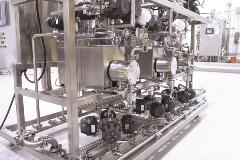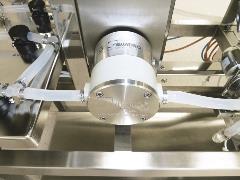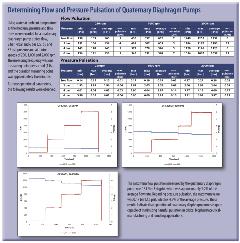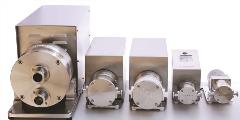CHROMATOGRAPHY, VIRUS FILTRATION AND TANGENTIAL FLOW FILTRATION ALL HAVE UNIQUE DEMANDS WITH QUATERNARY DIAPHRAGM PUMPS OFFERING THE LOW PULSATION AND SHEAR THAT IS CRITICAL TO THESE TECHNIQUES
By Glenn Hiroyasu
Introduction
Biopharmaceutical manufacturing may come in a wide variety of forms, but every iteration of unit operation must adhere to an unbending set of operational parameters and structures if the desired outcome – a viable, contaminant-free drug suitable for human or animal administration – is to be realized.
Three of the more common unit operations within the biopharmaceutical-manufacturing universe are chromatography, virus filtration and tangential flow filtration (TFF). In order for these unique operations to be implemented successfully, though, the operator must be aware of their specific operating characteristics. For example, chromatography requires constant fluid-flow rates during their operations, but may have varying pumping pressures. Virus filtration, on the other hand, will feature constant pumping pressures, but flow rates will change as the filters become clogged or fouled. And in TFF, the main challenge is attempting to keep the flow rate and pressure unchanging throughout the process.
While fluid transfer is taking place in any of these specific unit operations, it is important to know that the materials that are being transferred can be highly sensitive and delicate (and, in many cases, expensive), meaning that the pumping action must be low-pulsating and low-shear, lest the material be damaged.
This white paper will examine the material-handling challenges pertaining to flow rate and pressure in chromatography, virus filtration and TFF processes and illustrate why the design and operation of the quaternary diaphragm pump – rather than other technologies such as the lobe or peristaltic (hose) pump – makes it ideal for use in critical biopharmaceutical-manufacturing applications. Additionally, the paper will show how the quaternary diaphragm pump’s ability to operate consistently whether in a fixed stainless-steel production regime or in the increasingly popular single-use applications gives it the versatility to optimize biopharmaceutical-manufacturing maintenance, downtime, changeover and operational costs.
The Unit Operations
Let’s start by taking a closer look at three of the more popular unit operations in biopharmaceutical manufacturing:
Chromatography Columns
A typical chromatography column, whether it is glass, steel or plastic, is filled with resins that are compressed in a certain format through which the feed stream product flows and purifies the product by selective adsorption to a stationary phase (resin). Chromatography columns contain complex target-product adsorbing media that need careful handling. Protein A resin, for example, can cost as much as $10,000 a liter, making proper feeding of the resin extremely important.
Some chromatography systems require buffer gradients in order to achieve purification of the proteins. Buffers are compounds that are immune to changes in their pH level when limited amounts of acids or bases are added to them. For example, buffering salts have a wide pH range and can effectively stabilize the pH level of the material.
Quite often more than one buffer is required, which creates the need to use two or more pumps. In this application, high- and low-salt buffers are mixed continuously and with changing ratios in order to affect the adsorption of the target molecule to the chromatography resin. Because of this, precise pumping is required to achieve the right pH/conductivity conditions for specific adsorption and high-resolution purification. For example, a Buffer A and a Buffer B can be used to create a gradient that ranges from a low-salt buffer to a high-salt buffer in a linear fashion. Specifically, the process will begin with Buffer A producing 95% of the flow and Buffer B the remaining 5%. Over the course of the operation, the flow rates of Buffer A and Buffer B will decrease and increase in a linear fashion (90% for A and 10% for B, 75% for A and 25% for B, all the way to 5% for Buffer A and 95% for Buffer B)
1.
This requires a pumping technology that can produce a highly accurate flow with a high turndown ratio that can deliver low and high flow rates as the elution stage continues. Pump pulsation should also be minimized to prevent disturbance of the packed column2. If the pump is not able to meet these requirements, the correct buffer concentration may not be attained. Also, if the pumping action produces excessive pulsation, the buffers can be susceptible to experiencing spikes in their conductivity. This can affect the purification level of the product as the salt level in the buffer could be compromised.
Also, during the loading of the sample, it is not uncommon for the system’s back pressure to increase. Pumps that do not slip offer benefits in these situations since their flow rates will remain consistent and the linear velocity will remain stable. Simply put, a pump with minimal slip will have a more easily controlled flow rate that will need only incremental adjustments to the pump’s speed (measured in RPMs).
Virus Filtration
In biopharmaceutical manufacturing, virus-filtration systems are used to ensure the viability and safety of the drugs that are produced through the removal of potential contaminants from products that are created using cell cultures. Whereas chromatography features constant flow rates and variable pressures, the operation of virus-filtration systems is the opposite – most virus-filter applications use constant pressures with variable flows. In other words, you may have to raise and lower the operation’s flow rate or speed in order to maintain a constant pressure.
As mentioned, the flows change as the virus filter becomes clogged. Most typical virus-filtration systems run at a constant pressure, for example, 2 bar (29 psi), due to the nature of the tight pores in the filtering medium, but the flow rates will decrease as the filter’s pores become fouled. When this happens, the flow rate will not decrease in a linear fashion, which will adversely affect the performance of the filter, product yield and overall quality.
Some virus filters have been designed with a flux-decay capacity of up to 90% of the starting flux rate, which requires a pump that has both a high turndown ratio and produces minimal pulsation in the pumped fluid. Evaluation of viral clearance strategies requires demonstration of the equivalence of scalability from bench to manufacturing scale and vice versa3. Spiking studies for virus-filtration use a pressure vessel with a small surface area, which can be as little as 5 cm2 and demand a pump that has low-shear and low-pulsation operation if commercial-scale production levels are to replicate the small-scale studies. The use of low-pulsing pumps in these circumstances can ensure that pressure conditions during validation of the particular filter are not outside of the validated range.
Tangential Flow Filtration (TFF)
Also known as cross-flow filtration, in TFF the biologic feed stream flows tangentially across the filter membrane at positive pressure. As it passes across the membrane, the portion of the feed stream that is smaller than the membrane’s pore size passes through the membrane. This is different from what is known as normal-flow (NFF), or “dead-end,” filtration, in which the feed flows entirely through the filter membrane with the size of the pores determining which portion of the feed is allowed to pass through and which will remain trapped in the filter membrane.
TFF is different from NFF in biologic applications because the tangential motion of the fluid across the membrane prevents molecules from building up a compact gel layer on the surface of the membrane. This mode of operation means that a TFF process can operate continuously with relatively high protein concentrations with less fouling or binding of the filter.
To scale up a TFF process there are two variables that need to be successfully controlled. Recirculation (crossflow) is required to minimize formation of the gel layer and pressure as the driving force to push the permeate through the membrane. The recirculation rate needs to work in conjunction with the pressure (known as the trans-membrane pressure, or TMP, which is the average amount of pressure that is applied to the membrane). Maintaining a constant TMP is critical because if it is too high it can cause gel-layer formation that cannot be removed by recirculation, and if it is too low it results in low flux that will reduce process efficiency. In this instance, pumps that deliver low-pulsation flow characteristics will perform most reliably by decreasing the fluctuation in the variables.
So, in considering the functional design of chromatography columns, virus-filtration systems and TFF systems, the common thread in guaranteeing efficient, reliable, cost-effective operation is found in identifying and using a pump technology that is capable of producing both low-pulsation and low-shear operation despite varying flow rates and pumping pressures.
The Challenge
With these operational requirements in mind, over the years various pump technologies have been used or tested for chromatography, virus filtration and TFF processes. Two that are among the more popular choices of biopharmaceutical manufacturers are lobe and peristaltic pumps. Both, however, have been found to feature operational inefficiencies that may make them insufficient for use in the processes described above.
Lobe Pumps
Since many biopharmaceutical materials are contained in a low-viscosity aqueous solution, lobe pumps may not be a good choice because slippage can occur during their operation, which can vary between 10% to 100%, depending on the system’s back pressure. Slip will also result in increased shear damage and energy consumption, and if used in a long-duration recirculation loop, such as a TFF filtration system, there can be noticeable heat addition to the product that requires significant cooling efforts to protect the product from overheating.
Lobe pumps also have mechanical seals, which is a controlled product leak and does not provide full containment unless special (and oftentimes expensive) seals and seal barriers are used. The sterility required in biopharmaceutical handling also means that no outside contaminants can be introduced into the purification process, which is something that pumps with mechanical seals cannot reliably ensure.
Additionally, the necessary contact between a lobe pump’s internal parts can lead to wear and the generation of particles that can result in product contamination. Solid particulates, such as undissolved salt crystals, can cause severe damage to the lobes, resulting in damage to the entire manufacturing batch. Lobe pumps will ultimately cost more to operate because of the increase in power required to overcome the pump’s slippage.
Peristaltic (Hose) Pumps
The main shortcoming of peristaltic pumps is also the most obvious: their method of operation will undoubtedly produce pulsation, and, as noted, pulsation is always bad in biopharmaceutical manufacturing. Peristaltic pumps also have limited flow and pressure-handling abilities. For example, they cannot reliably produce the higher discharge pressures (such as 4 bar, or 58 psi) that are required in some fluid-handling applications.
They are also known to release some small quantity of hose material – in a process known as “spalling” – into the pumped product, which can compromise its purity. If the spalled hose material makes its way to the filter, it can foul the filter, making its operation not as efficient as it needs to be, which will also lead to contamination. Also, inconsistency of flow rate will result due to mechanical deformation of the hose during the pumping process.
In the end, the shortcomings of lobe and peristaltic pumps come down to two main things:
? If there is shear, which is common in lobe pumps, you will damage the pumped material
? If there is pulsation, an operational certainty with peristaltic pumps, you won’t have even flow, and without even flow, you won’t have accurate flow
The Solution
An effective solution to the operational shortcomings of lobe and peristaltic pumps can be the quaternary diaphragm pump.
The motivation behind the invention of the quaternary diaphragm pump goes back 30 years to the mid-1980s, at the time of what is now referred to as the “birth of the modern biotech industry.” In 1986, Frank Glabiszewski was an engineer for a German filter manufacturer and he was growing increasingly frustrated with the overall operation of the pumping technologies that were commonly used in chromatography and TFF applications.
“We were using peristaltic pumps but we found out that these pumps were not made for TFF applications. We were checking the marketplace looking for better pumps and spent 80% of our time looking for pumps,” Glabiszewski recalled. “One night I went home and I was sitting in my car frustrated after a pump failure and asked myself a question, ‘Which type of pump did Mother Nature invent to process sensitive biologic fluids like blood?’”
4
The answer, of course, was the human heart, and with that in mind, Glabiszewski began working with his friend and engineering partner, Josef Zitron, to perfect the design and operation of the quaternary diaphragm pump technology. When the new technology was finalized in 2000, the pair created a company that would begin producing quaternary diaphragm pumps for use in biopharmaceutical-manufacturing processes. As the duo’s invention grew in popularity over the past 15 years, the technology was also modified so that it could employ disposable plastic heads and wetted parts to make it applicable in the burgeoning single-use biopharmaceutical-production marketplace.
The operating principle of the quaternary diaphragm pump most closely resembles the operation of the human heart because the four-piston diaphragm technology enables a gentle pumping action through soft “heartbeats.” This action produces four overlapping pumping strokes of the pistons that efficiently reduce pulsation since each stroke of the four diaphragms is generated by an eccentric shaft that is connected to an electric motor.
The quaternary diaphragm pump’s method of operation allows it to gently, safely and securely convey low-viscosity aqueous solutions and biopharmaceutical materials that are highly sensitive to shear forces and pulsation while being pumped. Since the four-piston design of the pump does not require any mechanical seals or wetted rotating parts, total product containment is ensured without any abrasion or particulate generation. The pump’s method of operation also produces risk-free dry-running and self-priming capabilities with high turndown ratios. A pump technology with high turndown ratios allows for the creation of a broad flow range, which makes the pump applicable for utilization in a wide range of process applications.
With regards to specific unit operations, quaternary diaphragm pumps can be used to pack chromatography columns and then pump the biopharmaceutical material through the column, both of which are critical concerns that require low pulsation with accurate and constant flow rates and pressures. In TFF applications, quaternary diaphragm pumps deliver the consistent flow control that is essential in producing optimal filtrate yields.
In today’s evolving biopharmaceutical-manufacturing processes, quaternary diaphragm pumps are also rapidly becoming a first-choice technology in increasingly popular single-use production setups. Basically, a single-use pump enables biopharmaceutical manufacturers to eliminate the cost of cleaning and validating their pumps by using a pump with a replaceable pump head. The result is not only a quicker production process, but one that delivers preferred levels of product purity and sterility with no chance for cross-batch or cross-product contamination.
Here are some of the other advantages that can be realized when quaternary diaphragm single-use pumps are used:
? Can be used for one product or in one production campaign
? At the conclusion of the production campaign, the pump chamber that has come in contact with the fluids is disposed of
? Can be used for a set amount of time before the wetted parts are replaced, which eliminates elevated maintenance costs
? If the operator needs to use a stainless-steel pump, the plastic pumping chamber can be replaced with a stainless-steel one
? If there’s a pump failure, the old chamber can be taken out and replaced with a new one in five minutes
? Used when cleaning in place (CIP) or steam sterilization is not practical or possible. This represents a significant simplification and cost reduction to the overall process as there are no contaminated cleaning chemical and water solutions that need to be treated and disposed of. The costs to properly treat and dispose the cleaning fluids can alone be the driver to require use of single-use alternatives.
Of course, not every pump technology is completely perfect for every characteristic of a specific fluid-handling application. In this instance, the design and operation of the quaternary diaphragm pump limits it to handling fluids that have a maximum viscosity of 1,000 centipoise (cPs) and that contains particulates up to 0.1 millimeter in diameter.
Conclusion
The importance of biopharmaceuticals means that any and all products must meet strict demands regarding their manufacture. This includes ensuring that no damage is done to component materials during critical chromatography, virus-filtration or TFF processes. While lobe and peristaltic pumps have been preferred pumping technologies for these unit operations, a better choice can be the quaternary diaphragm pump, the operation of which greatly reduces the chance that pulsation and shear will compromise the safety and effectiveness of the end product.
References:
1. http://www.pall.com/main/biopharmaceuticals/product.page?id=33058
2. L. Hagel, G. Jagschies and G. Sofer, Handbook of Process Chromatography: Development, Manufacturing, Validation and Economics, 1997
3. H. Aranha and S. Forbes, “Viral Clearance Strategies for Biopharmaceutical Safety” Pharmaceutical Technology, June 2001
4. Video: “Quattroflow?: The New Standard in Biopharmaceutical Pump Excellence”
About the Author:
Glenn Hiroyasu is the Americas Development Manager for Quattroflow? Fluid Systems GmbH, Kamp-Lintfort, Germany. He can be reached at glenn.hiroyasu@psgdover.com. Quattroflow offers innovative quaternary diaphragm pump technology for use in pharmaceutical and biopharmaceutical applications that require gentle displacement, reliability, product safety, purity and cleanability. Quattroflow? is a brand of Almatec? Maschinenbau GmbH, Kamp-Lintfort, Germany, which is a product brand of PSG?, Oakbrook Terrace, IL, USA, a Dover company. PSG is comprised of several of the world’s leading pump brands, including Abaque?, Almatec?, Blackmer?, Ebsray?, EnviroGear?, Griswold?, Mouvex?, Neptune?, Quattroflow?, RedScrew? and Wilden?. You can find more information on Quattroflow at quattroflow.com and on PSG at psgdover.com.

Chromatography, virus filtration and tangential flow filtration (TFF) are three of the more common unit operations that can be used in the manufacture of biopharmaceuticals. In order to provide efficient, reliable and cost-effective processes in all three unit operations, as well as guaranteeing the production of drugs that are suitable for human or animal consumption, manufacturers must utilize a pump technology that features low-pulsation and low-shear operation even when encountering variable flow rates and pumping pressures. A technology that meets all of those operational requirements is the Quaternary Diaphragm Pump from Quattroflow
?, which also possesses the versatility to operate effectively in a fixed stainless-steel production setup, as well as in the increasingly popular single-use manufacturing applications.

After its invention in 2000, quaternary diaphragm pump technology from Quattroflow
? quickly gained popularity as a low-pulse, low-shear option for the various unit operations that can be used in the manufacture of biopharmaceuticals.



Quattrolfow
? offers a complete family of stainless-steel quaternary diaphragm pumps for use in biopharmaceutical manufacturing, many of which can also be outfitted with disposable plastic wetted parts and pump heads.